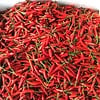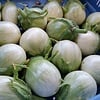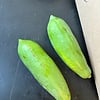Banana leaf
Description/Taste
Banana leaves are large, wide, elongated, and slightly rounded, averaging two meters in length, a half a meter in width, and 8-12 leaves per tree. The surface of the leaves are waxy, flexible, and glossy, and range in color from lime, olive green, to dark green. There is a central midrib that runs the length of the leaf and two laminas, or leaf halves are found on either side of the midrib. The leaves do not have branching veins, and this makes them vulnerable to tearing easily. Banana plants also have a pseudostem, which is a false stem that looks like a trunk but is multiple fleshy leaf sheaths that are tightly overlapped. Banana leaves have a grassy and sweet, green flavor.
Seasons/Availability
Banana leaves are available year-round.
Current Facts
Banana leaves, botanically classified as Musa acuminate, grow on a perennial herbal shrub that resembles a tree but is classified as a plant. There are many varieties of Banana plants growing in tropical regions, and some can grow up to 7-8 meters tall. Bananas are believed to have been one of the world’s first cultivated fruits, and the leaves have become a popular cooking tool. Banana leaves are not typically consumed but are used as a waterproof wrapper to cook food and add flavor. In addition to cooking, they are also used as plate liners, cups, bowls, and as a writing tablet.
Nutritional Value
Banana leaves contain polyphenols, which are natural antioxidants. Some of these polyphenols are also found in green tea.
Ethnic/Cultural Info
In addition to culinary uses, Banana leaves have also been used in the Buddhist and Hindu religion as decorations and as bowls, plates, and offerings in special religious celebrations such as marriage ceremonies. They are also used in India and the Philippines to construct fences and thatched roofs and have even been used as umbrellas.
Geography/History
Banana trees are believed to have originated in Southeast Asia between 8,000-5,000 BCE, were then spread to the new world via explorers, and became commercially cultivated in the late 1880s. Today Banana leaves are widely available in specialty markets and on online retailers across the world including Asia, Southeast Asia, Central Africa, Latin America, Europe, Australia, the United States, and the Caribbean.



 vegetables
vegetables
 fruit
fruit
 chilli
chilli
 eggplant thai
eggplant thai
 NEW project - GREEN PAPAYA THAI.
NEW project - GREEN PAPAYA THAI.





